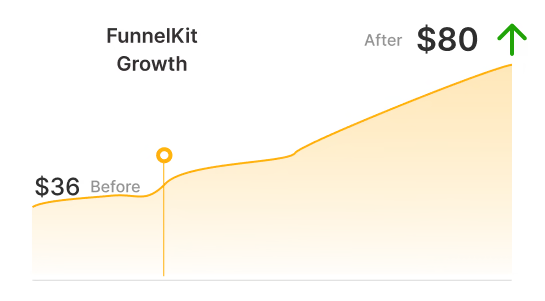![How To Set Up WooCommerce Google Analytics Integration [2026]](https://funnelkit.com/wp-content/uploads/2024/07/woocommerce-google-analytics-integration-funnelkit.jpg)
Do you want a reliable WooCommerce Google Analytics integration that tracks real customer behavior (not just page views)?
Many WooCommerce stores install Google Analytics but never configure it correctly for eCommerce tracking.
Critical events like add-to-cart, checkout start, purchases, and upsells go untracked, leaving store owners blind to what’s actually driving (or blocking) revenue.
The impact is real.
Without a complete WooCommerce Google Analytics setup, you can’t see where customers drop off or which products and funnels perform best.
At FunnelKit, we’ve helped 40,000+ WooCommerce stores, and the pattern is clear: stores with accurate analytics make faster, smarter growth decisions.
While tools like Google Site Kit can track basic page views, they often fail to capture the nuances of the checkout journey, such as upsells, order bumps, and granular cart abandonment.
This guide solves that problem.
In this article, you’ll learn how to integrate Google Analytics 4 (GA4) with WooCommerce and set up meaningful eCommerce event tracking so every critical customer interaction is measured and turned into actionable insights.
Why You Should Integrate Google Analytics with WooCommerce?
I often see owners celebrating “traffic spikes” while their bank accounts remain stagnant. This is the danger of shallow analytics.
Integrating Google Analytics 4 (GA4) with WooCommerce isn’t just about counting visitors; it is about forensic business intelligence.
Here is why this integration is the backbone of a scalable store:
1. Find the conversion leaks in your funnel
The WooCommerce dashboard shows total sales. It doesn’t show how many users added a product to the cart, started checkout, and then left due to shipping costs, payment issues, or trust concerns.
With GA4’s event-based funnel tracking, you can see exactly where users drop off on the product view, add to cart, checkout, or payment.
If you notice a sharp drop at the payment step, the issue is likely related to checkout (trust signals, gateway errors, UX), not your product or traffic quality.
2. Stop guessing where revenue comes from
You spend money across multiple channels, such as Facebook Ads, Google Ads, email, organic search, but WooCommerce alone doesn’t tell you which channel actually generated the sale.
Or a partial or broken GA4 setup with duplicate purchase events, missing transactions, or misfired events leads to incorrect ROAS and funnel decisions.
Proper WooCommerce GA integration ensures clean, reliable revenue data you can act on with confidence.
GA4 tracks the source and medium of every transaction. You may discover that Facebook drives traffic, but Google Ads drives buyers.
With this clarity, you can reallocate budget to channels that generate revenue, not vanity metrics.
3. Track revenue that WooCommerce analytics misses
Modern WooCommerce funnels go beyond simple product purchases. Order bumps, upsells, and post-purchase offers often contribute a significant portion of total revenue, but standard analytics frequently miss them.
With the WooCommerce Google Analytics integration plugin, such as FunnelKit, you can track custom GA4 events for order bumps and one-click upsells.
If one upsell converts at 15% and another at 2%, swapping or optimizing them can immediately increase Average Order Value without increasing traffic.
With proper GA4 integration with WooCommerce, you can ensure your store continues to collect actionable data even as cookies, browsers, and regulations evolve.
Table of Contents
- 1 Types of Google Analytics Properties
- 2 Prerequisites for WooCommerce Google Analytics Setup
- 3 Types of Events That Can Be Tracked
- 4 How to Set Up WooCommerce Google Analytics Integration and Enable Event Tracking?
- 5 How to Test Whether Events Are Capturing in Google Analytics?
- 6 Frequently Asked Questions (FAQs) on WooCommerce Google Analytics Integration
- 7 Do I need Google Analytics with WooCommerce?
- 8 How do I connect Google Analytics to WooCommerce?
- 9 Can I track events of both UA and GA4 iterations with FunnelKit?
- 10 Can I track individual product performance with Google Analytics?
- 11 Will this duplicate my data if I already have Site Kit installed?
- 12 Can I track subscriptions?
- 13 How do I know if my data is accurate?
- 14 Ready to Track Conversions with WooCommerce Google Analytics Integration?
Types of Google Analytics Properties
Google Analytics has two types of properties:
- Universal Analytics (UA): The earlier version of Google Analytics focused on tracking individual user interactions on a website. It uses a measurement model that depends on sessions and page views.
- Google Analytics 4 (GA4): Google Analytics 4 offers a more comprehensive approach, incorporating machine learning and AI to understand user behavior across platforms. Its measurement model is based on events and parameters across channels and devices.
GA4 enables action-level tracking for add-to-cart, checkout steps, and purchases. Plus, it lets you attribute revenue to products, campaigns and funnels.
It even lets you evaluate checkout elements like upsells and order bumps, and identify high-impact pages and conversion bottlenecks with real-time validation in DebugView.
Prerequisites for WooCommerce Google Analytics Setup
You need these prerequisites to set up your WooCommerce Google Analytics integration. The entire process takes no more than 15 minutes.
- A Google account with access to Google Analytics
- WordPress admin access to install plugins and modify settings
- WooCommerce installed and activated with at least one product in the catalog
- A tracking solution: FunnelKit Funnel Builder (recommended), MonsterInsights, GTM4WP, or manual implementation
Choose your integration method
There are three different ways to connect GA4 to WooCommerce.
Option 1: FunnelKit Funnel Builder (recommended)
Best for: Stores wanting comprehensive tracking without code
FunnelKit’s built-in pixel tracking feature handles both standard eCommerce events and custom funnel events (order bumps, upsells, and downsells).
It not only lets you set up highly optimized store checkouts, opt-in pages, upsell offers, etc., but it also offers deep integration with Google Analytics.
The free Lite version includes GA4 integration (no premium purchase required). You don’t need an extra plugin like the WooCommerce Google Analytics plugin to track different events on your website.
Option 2: Google Tag Manager and GTM4WP
Best for: Technical users requiring granular control
GTM4WP (Google Tag Manager for WordPress) pushes WooCommerce information to the data layer, which GTM then sends to GA4.
This approach offers flexibility but requires expertise in GTM.
Option 3: MonsterInsights or similar plugins
Best for: Users wanting in-WordPress Google Analytics reporting
These plugins provide dashboard analytics within WordPress. They are user-friendly but may lack support for custom funnel tracking.
Types of Events That Can Be Tracked
See the list of events that you can track via WooCommerce Google Analytics integration:
Common Google Analytics events
- Page view: When a user lands on any page of your WooCommerce store
- View item: The user views an item on your store’s product page
- Add to cart: Track when customers add a product to their cart
- Begin Checkout: When the user starts the checkout process
- Add shipping info: Triggered when shipping details are entered
- Add payment info: When a user adds the payment information during the checkout
- Purchase: User successfully makes a purchase (usually denoted by when a user goes from checkout to the thank you page)
These events form the foundation of GA4’s eCommerce and funnel reports.
FunnelKit specific events
In addition to standard GA4 events, FunnelKit tracks conversion-focused actions that are typically missed by basic analytics setups:
- Lead event: Triggered when a user submits an opt-in form
- Order bump events: The user accepts the order bump offer at checkout and adds it to their cart.
- Custom funnel event step: The user reaches a specific step in the sales funnel created with FunnelKit. It includes all the pages such as optin page, optin confirmation, sales page, checkout, upsell, downsell and thank you page.
This allows you to measure performance at every stage of your sales funnel, not just the final purchase.
FunnelKit can track site-wide events and each step in your sales funnels on your website.
By implementing site-wide tracking, you can gather detailed real-time data on how visitors interact with your website, which pages they visit, how long they stay, and much more.
This eliminates the need for third-party pixel plugins, allowing you to do everything from FunnelKit.
How to Set Up WooCommerce Google Analytics Integration and Enable Event Tracking?
FunnelKit is compatible with both UA and GA4 integration.
Since Google has deactivated its UA iteration and replaced it with GA4, we’ll show you how to set up WooCommerce GA4 integration.
Step 1: Find Google Analytics 4 ID
If you don’t have a GA4 property yet, you can set it up using this guide.
Log in to your Google Analytics account by entering your Google Suite credentials.
Once you’re logged in, go to 'Admin' on the bottom left menu of your screen.
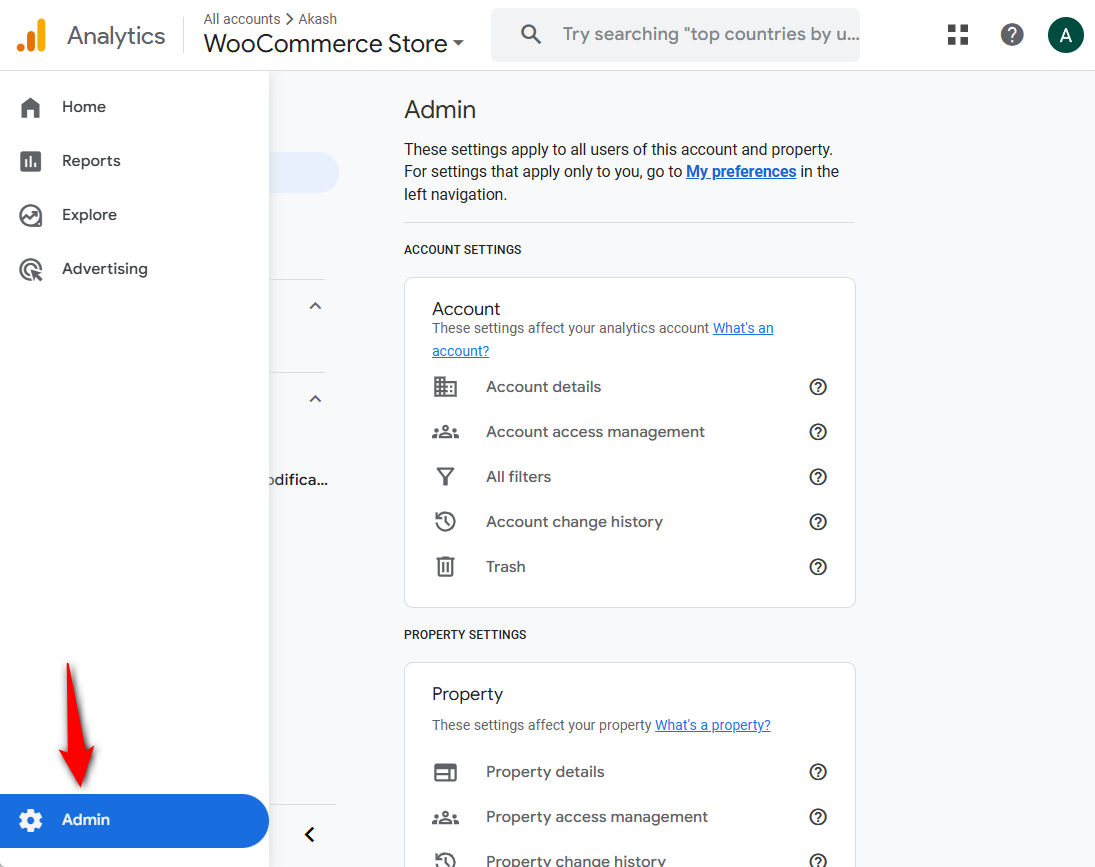
On your Google Analytics account, create a new GA4 property from your Admin dashboard:
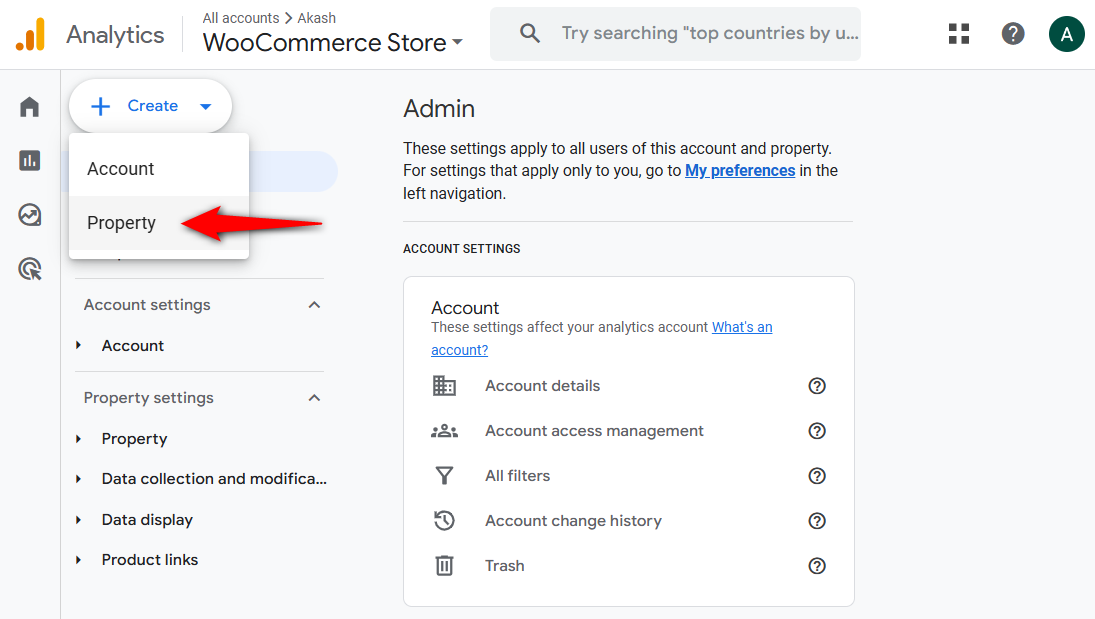
Google Analytics 4 property name
Enter the name of your Google Analytics 4 property and set the reporting zones along with the currency of your online store.
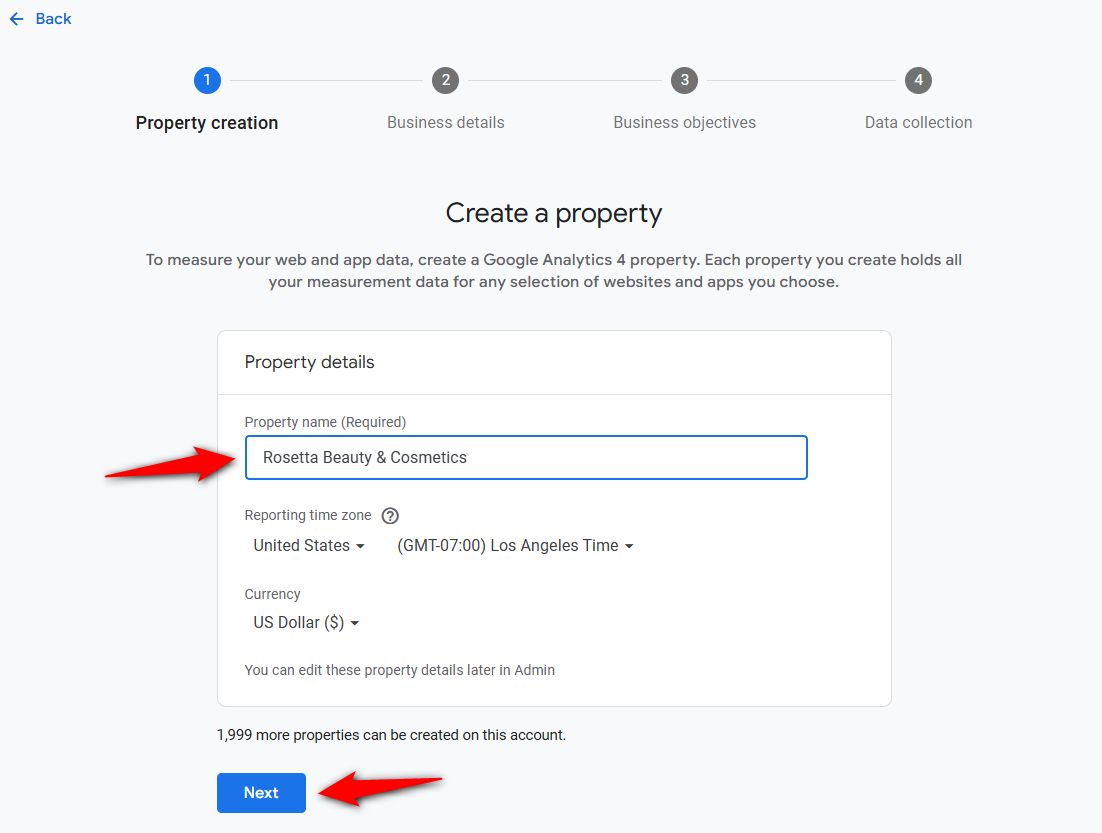
Next, select the information about your business including the industry and size of your business.
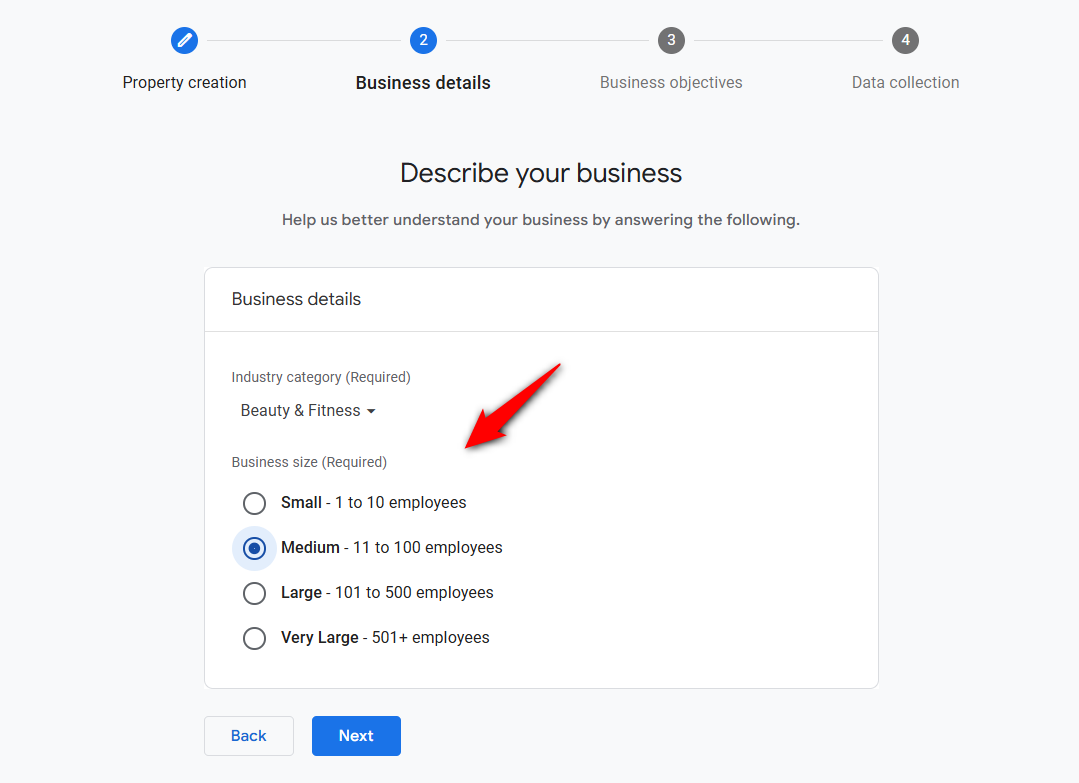
Choose your business objectives in the next step to create your Google Analytics 4 property.
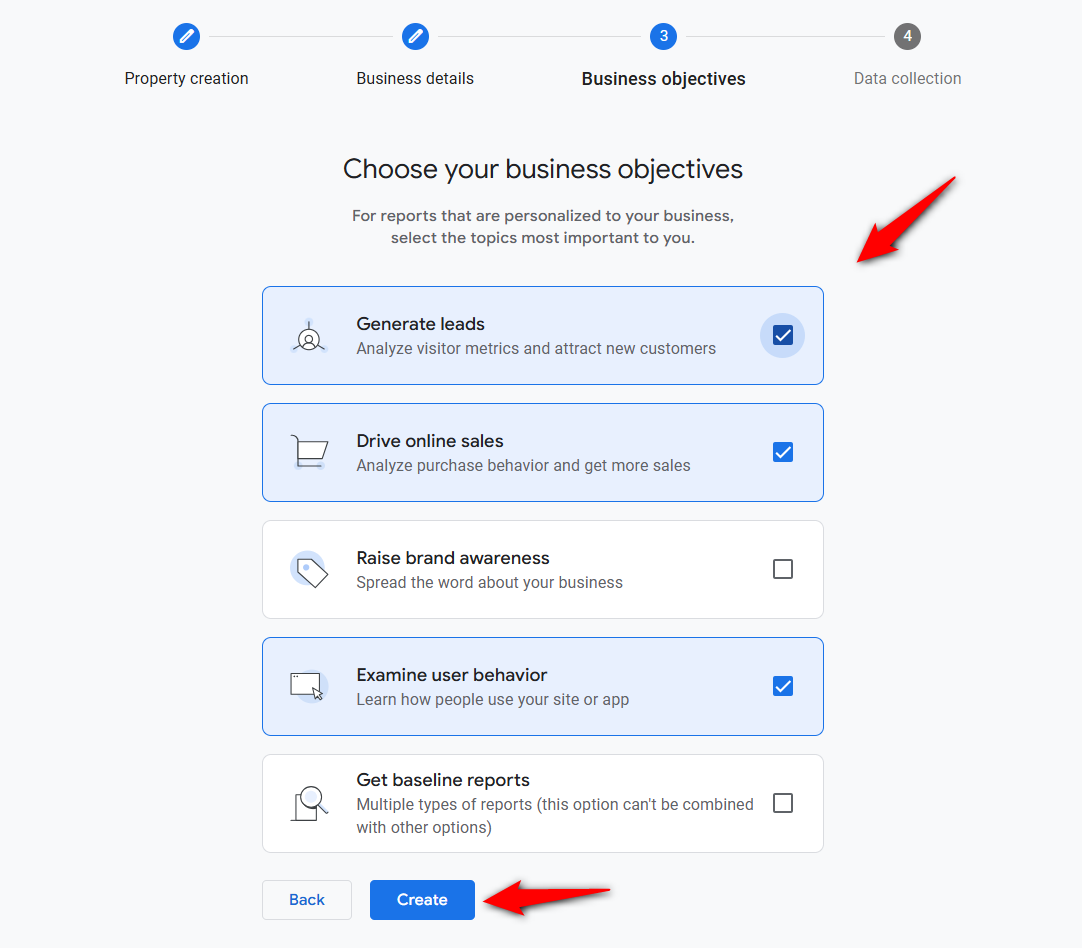
Clicking on ‘Create’ will create a new GA4 property. All you need to do is configure it for your WooCommerce store.
Set up the data collection
Now, you need to set up the platform for data collection. For that, choose a platform of “Web” for your WooCommerce store.
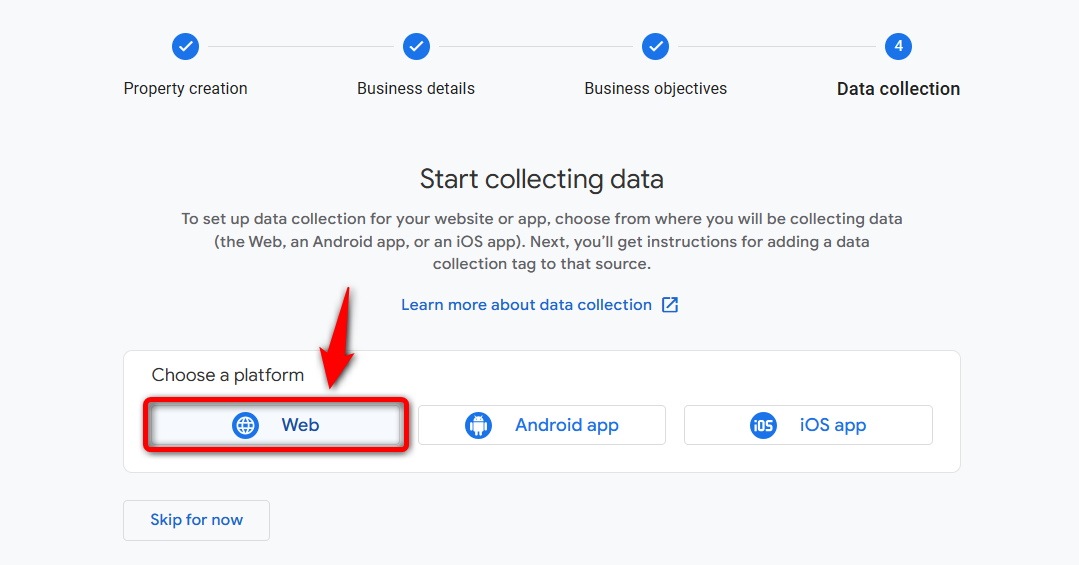
Next, enter the URL of your WooCommerce store and the name of your stream.
Make sure to enable the enhanced measurement option there. It allows you to measure interactions and content on your website in addition to usual page views.
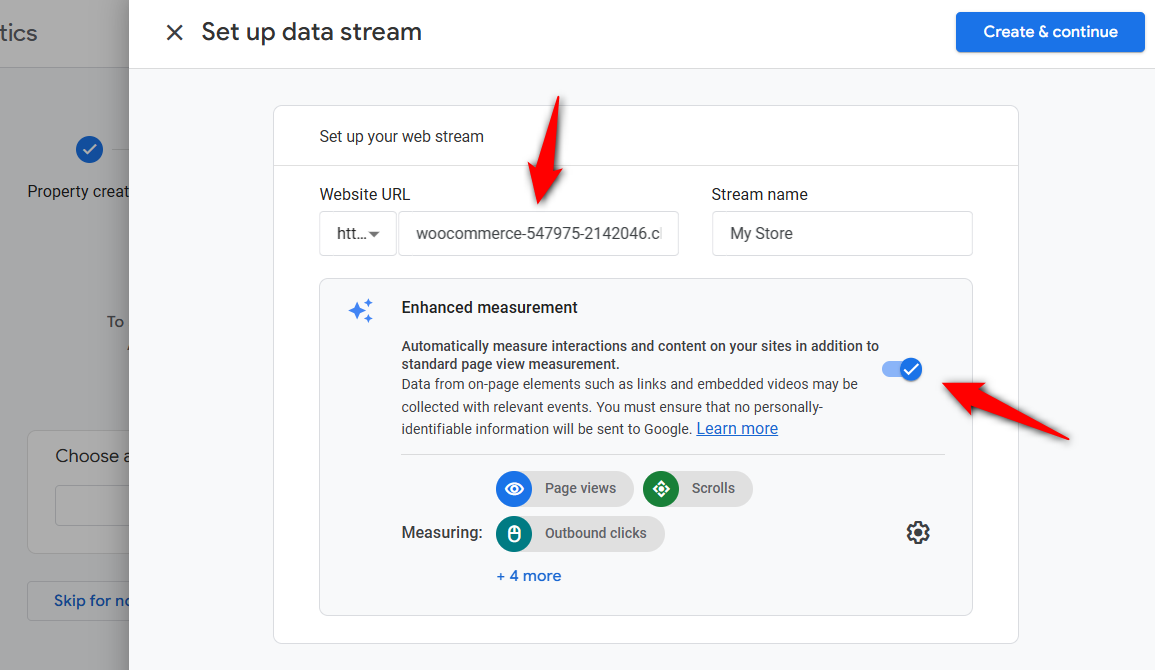
Clicking on ‘Create & continue’ will successfully create your data stream.
Simply close the next Tag window, and you’ll be able to see your Google Analytics 4 Measurement ID:

Copy this Google Analytics 4 Measurement ID.
Step 2: Add the Google Analytics 4 ID to WooCommerce
Navigate to FunnelKit ⇨ Settings ⇨ Pixel Tracking section within FunnelKit’s Funnel Builder.
Under Google Analytics, paste the Analytics ID.
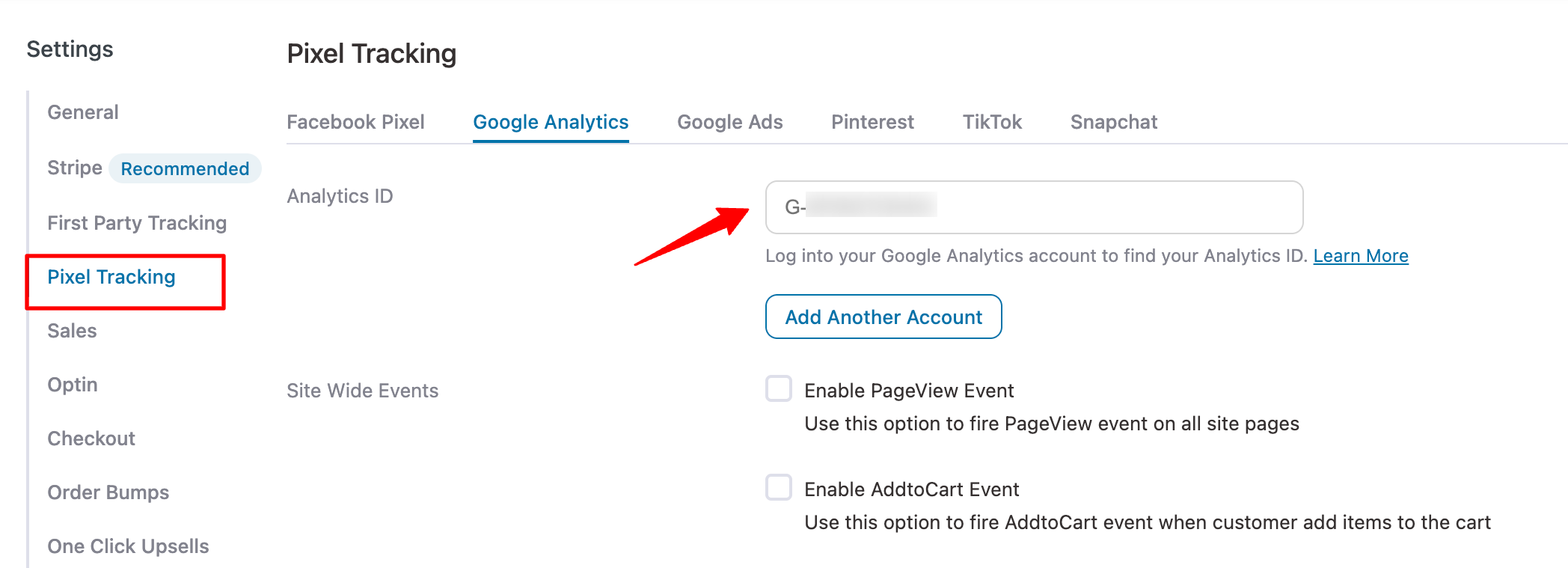
If you have multiple GA4 properties, click Add Another Account and enter each Analytics ID using the same process. You can add as many as you need.
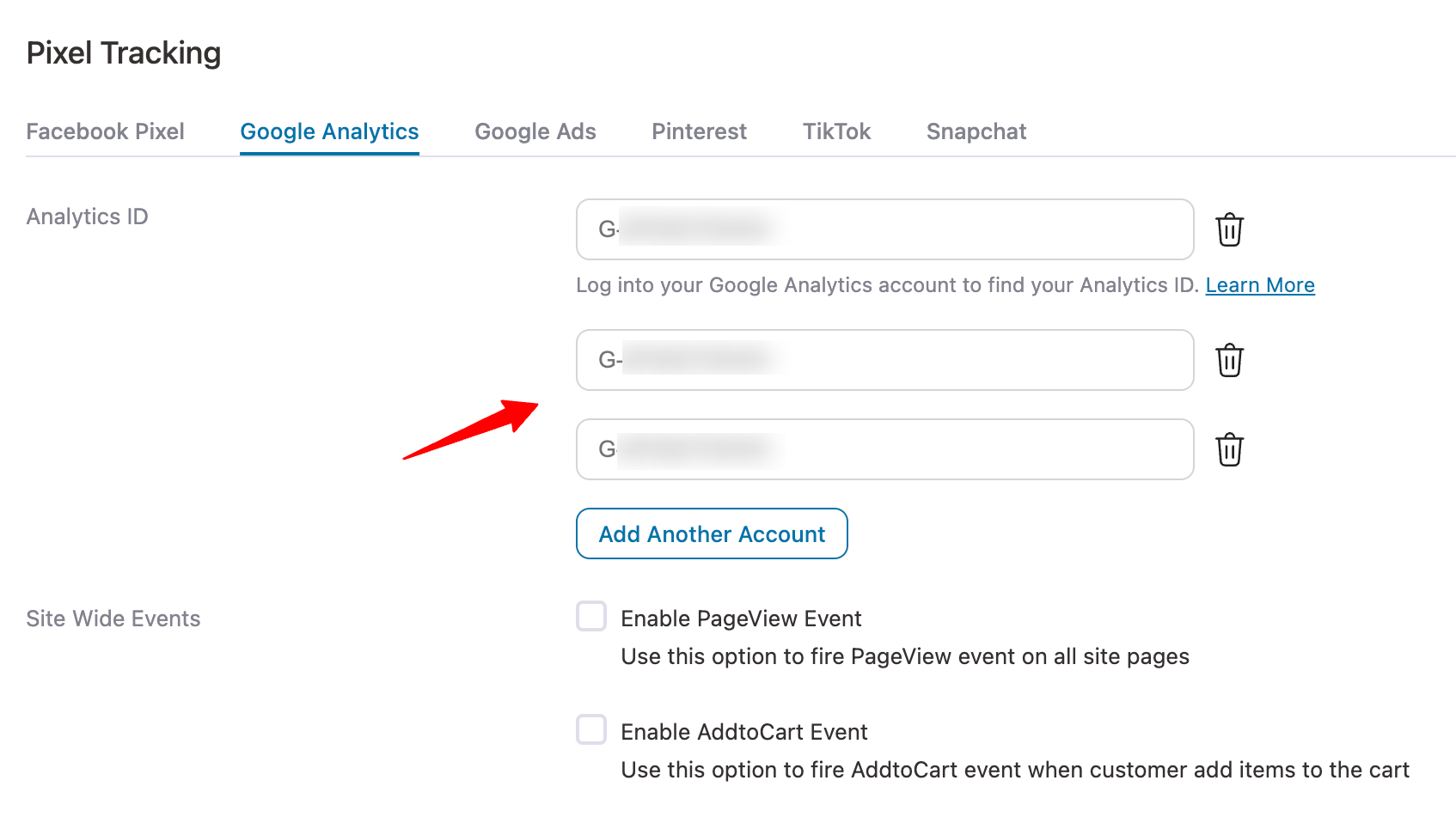
That’s it! You have successfully connected Google Analytics to your WooCommerce store.
You don’t need to enable any extra E-Commerce tracking settings; FunnelKit takes care of everything. Then, move on to the next step.
Step 3: Enable the different events you want to track
Here, you can enable the events you want to track with FunnelKit.
Here, enable the events you want to track on your website with FunnelKit.
Site-wide events
- Page View
- Add to Cart
- View Item
Sales page events
- Page View
Optin page events
- Page View
- Lead
Order Bump events
- Add to Cart
- Order Bump Conversion
Checkout page events
- Page View
- Add to Cart
- Begin Checkout Event
- Add Payment Info Event
Purchase events
- Page View
- Purchase
Track Steps
- Enable custom tracks
Enable custom funnel steps
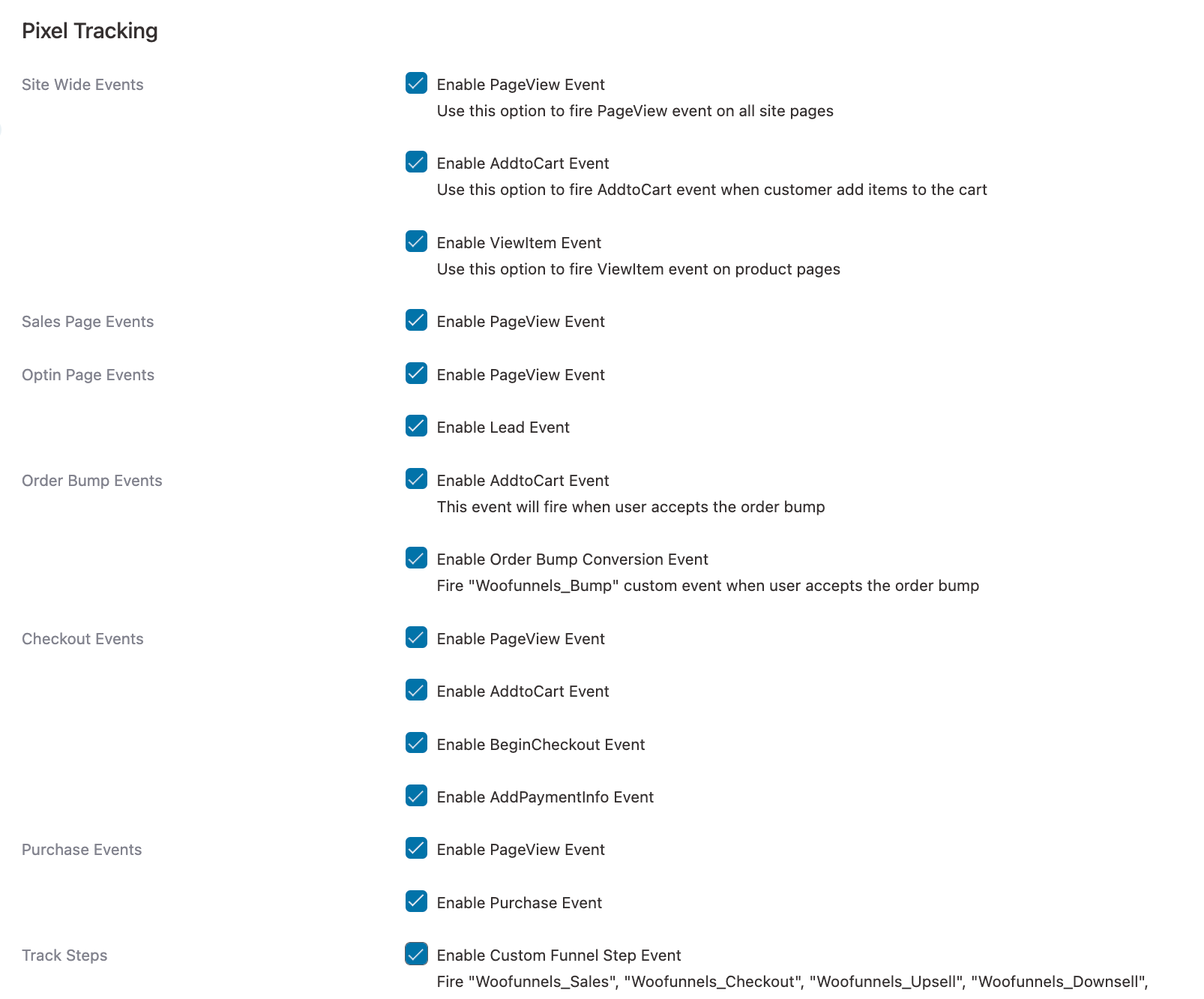
Advanced
- Enable sending the parent product ID if your catalog doesn’t include variants.
- Add a prefix or suffix to the
content_id(optional). - Check to exclude shipping and/or taxes from the total.
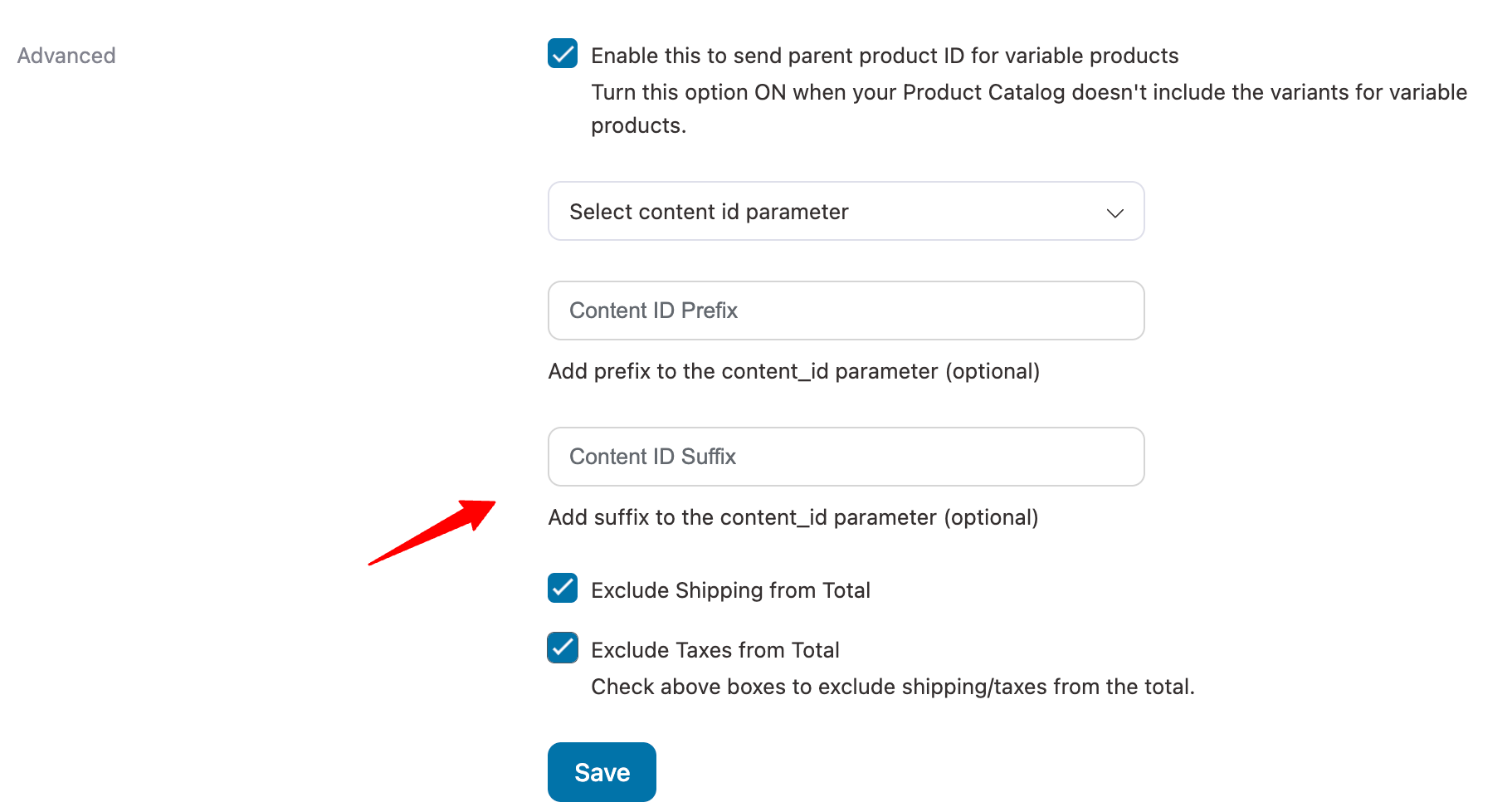
Once done, click on the 'Save Changes' button to lock in all the changes made. This section answers your 'How do I track WooCommerce transactions in Google Analytics?' query.
Well done! This completes your WooCommerce Google Analytics integration.
How to Test Whether Events Are Capturing in Google Analytics?
Follow the method below to test the events in your WooCommerce store and check whether they are captured in Google Analytics.
Here, we’ll be testing the events for both Universal Analytics and Google Analytics 4 properties:
1. Add the domain to Google Tag Assistant
Go to Google Tag Assistant and add the domain.

Enter the URL of your website and click on the ‘Connect’ button.
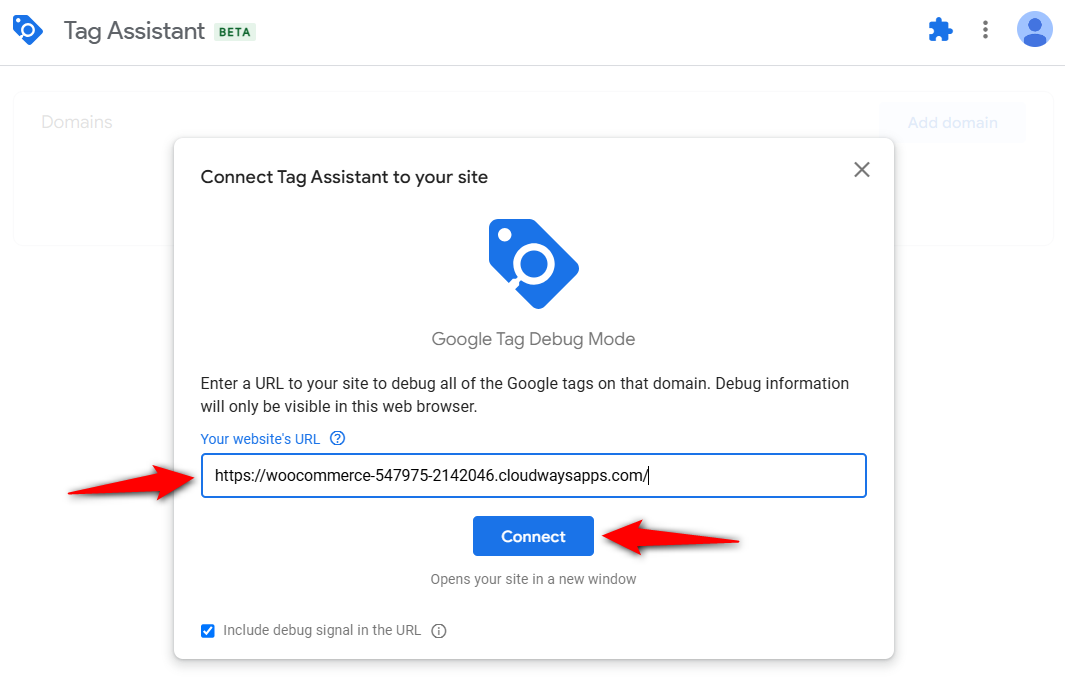
It’ll open up your website in a new tab.
Now, navigate to the pages in your store, and the extension will show the events that were triggered in real-time.
Click on ‘Continue’ and start testing the WooCommerce Google Analytics integration.
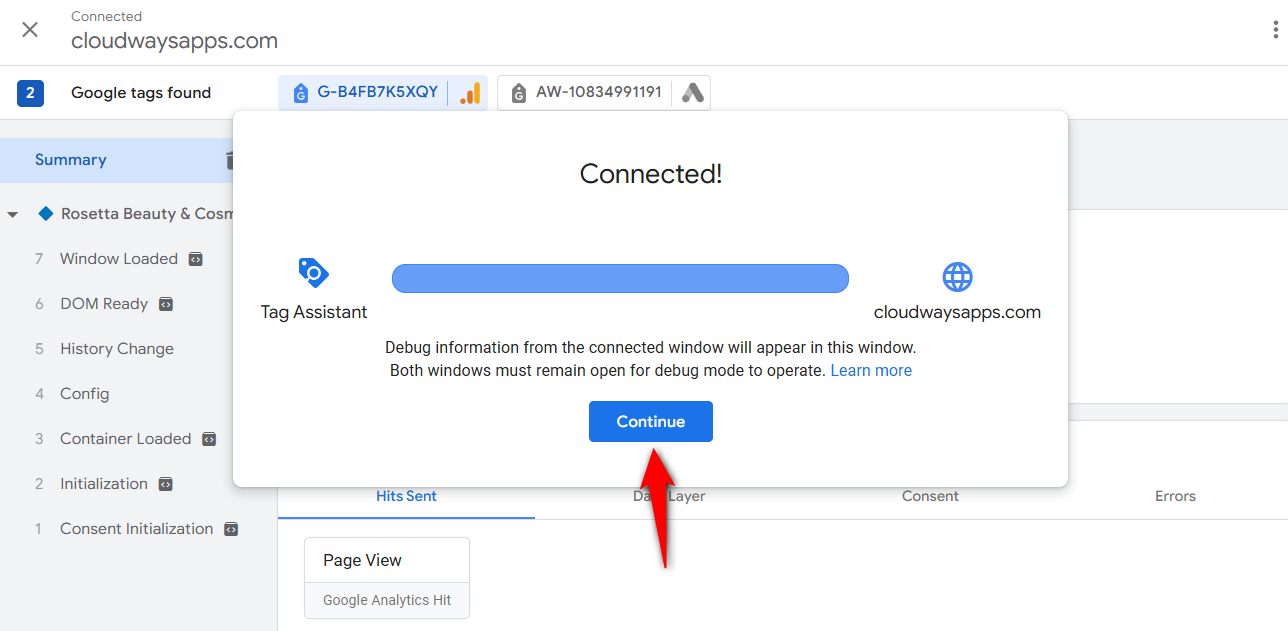
2. Navigate to your website and check the triggered events
Let’s now navigate to our WooCommerce website from the previous tab opened in point 1.
Adding an item to the cart
These are the events that get captured under Google Analytics 4 - WooCommerce integration:

As you can see, it has started capturing the events for your GA4 property.
If you click on any of these blocks, you can see the detailed event getting captured:
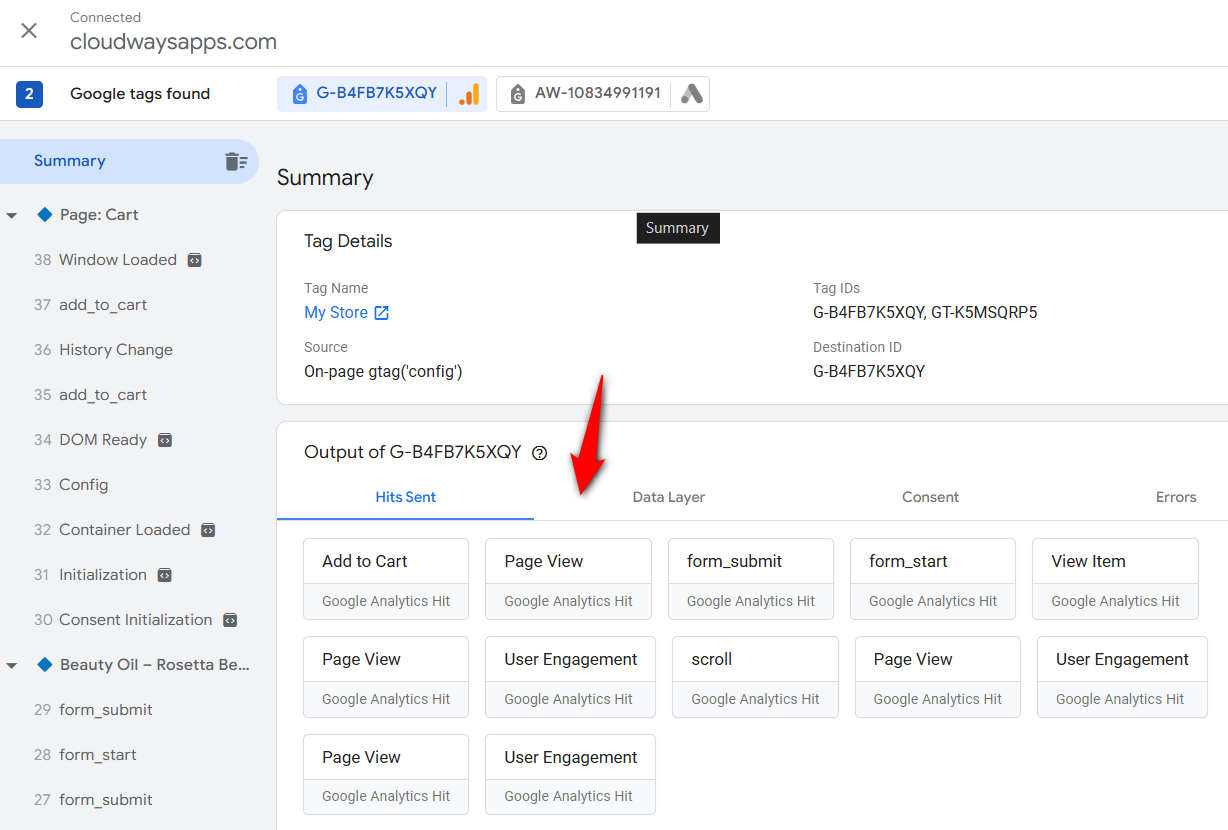
If you click on any of these blocks, you can see the detailed event getting captured:
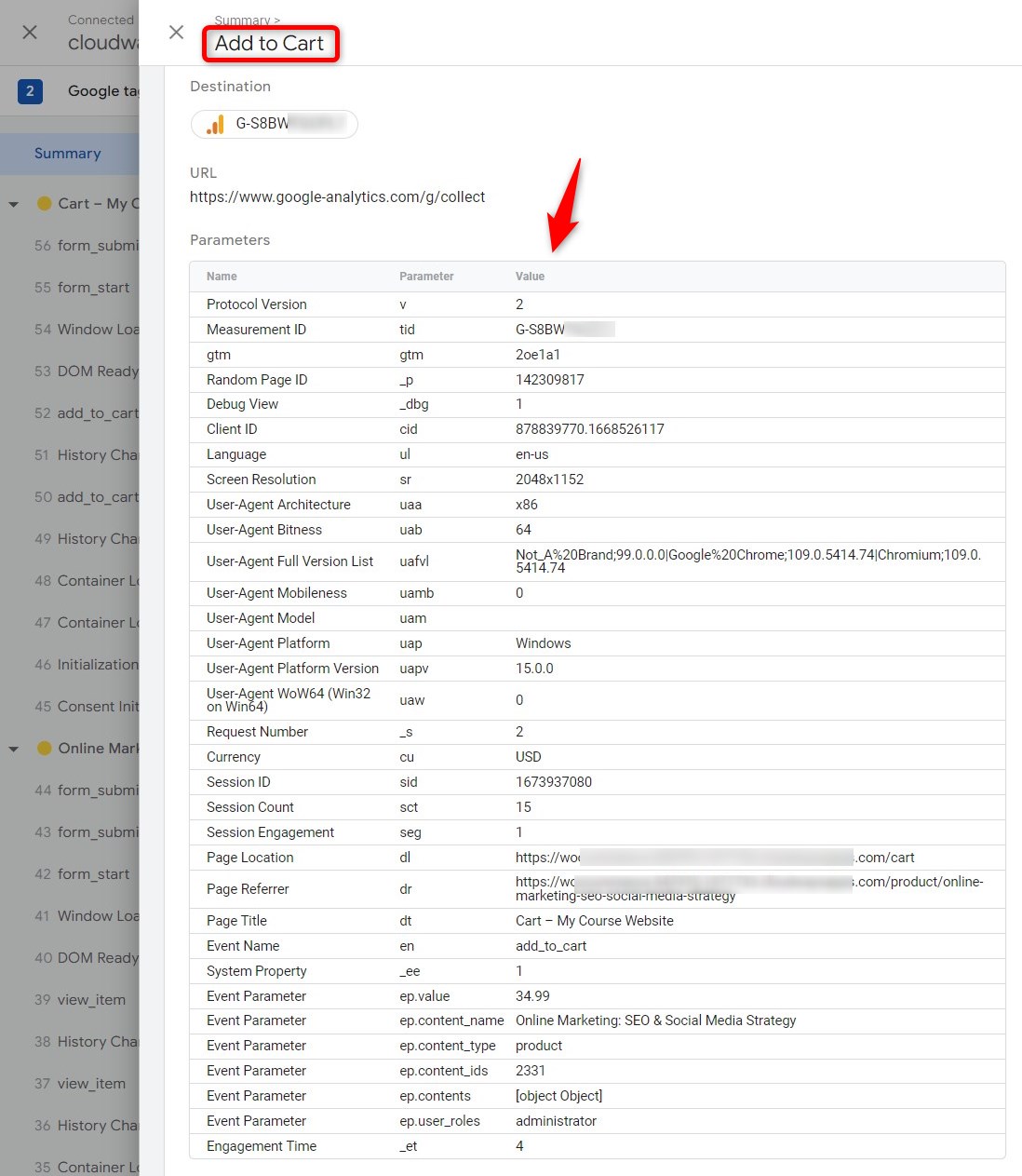
Initiating the Checkout process and making a purchase
Next, we will start the checkout process and make a test purchase by going through the payment gateway.
These are the WooCommerce GA4 eCommerce tracking events that got triggered in the whole shopping process:
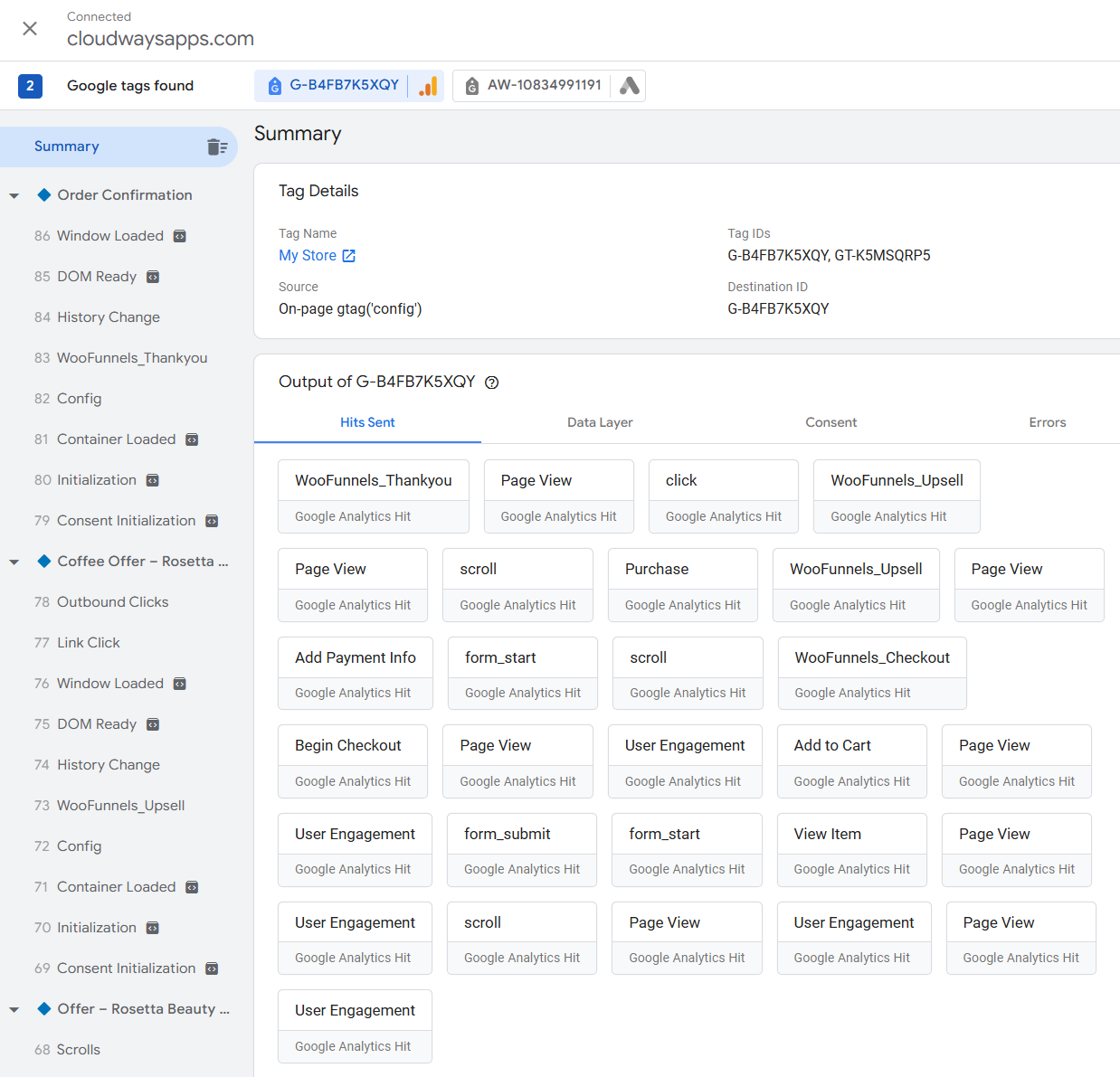
Furthermore, you can also see the data in real-time from the Google Analytics dashboard.
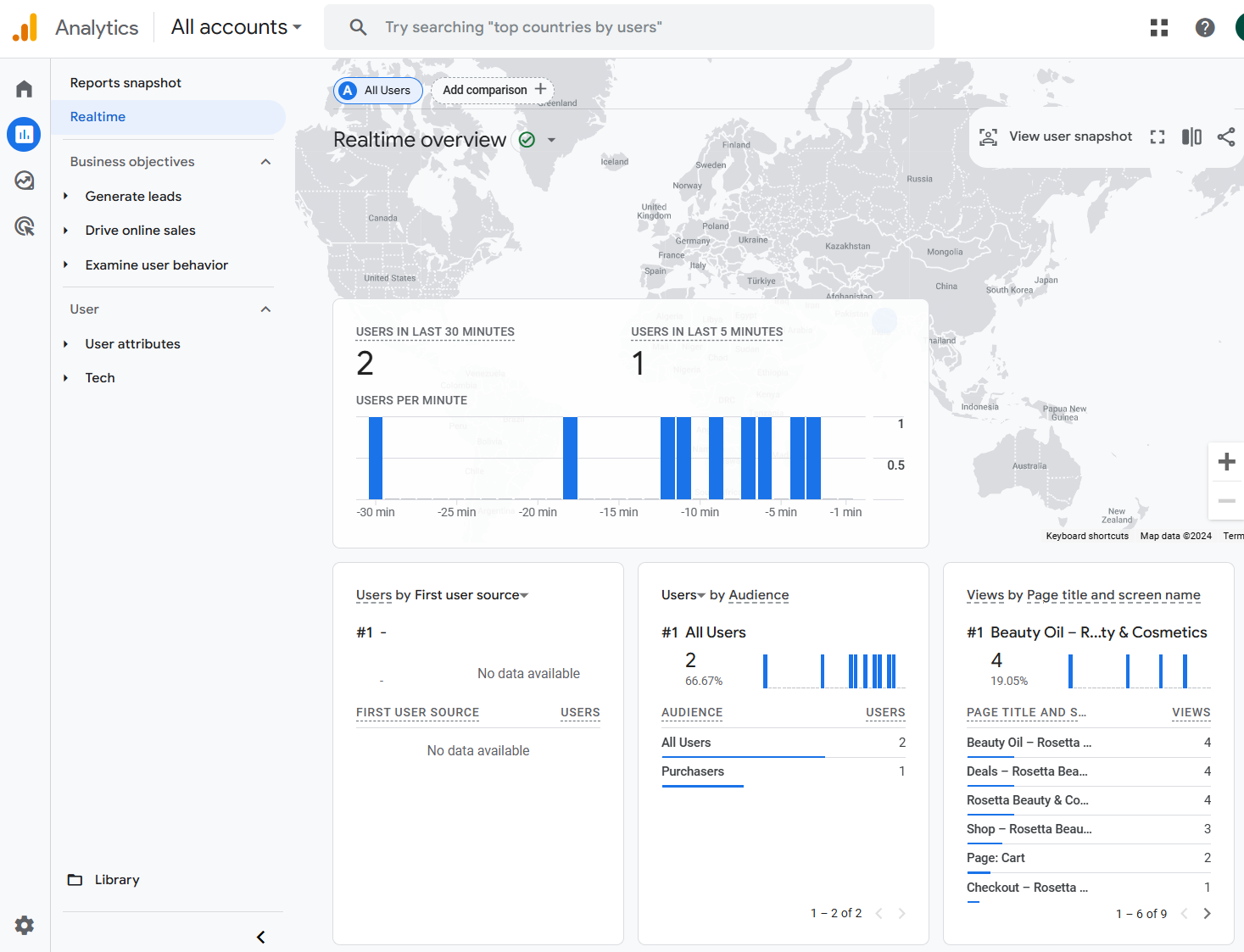
Monitor the events in DebugView
You can monitor all the events with the 'DebugView' option in Google Analytics.
This allows you to see all your data in a single timeline.
Go to Admin ⇨ DebugView inside your Google Analytics account.
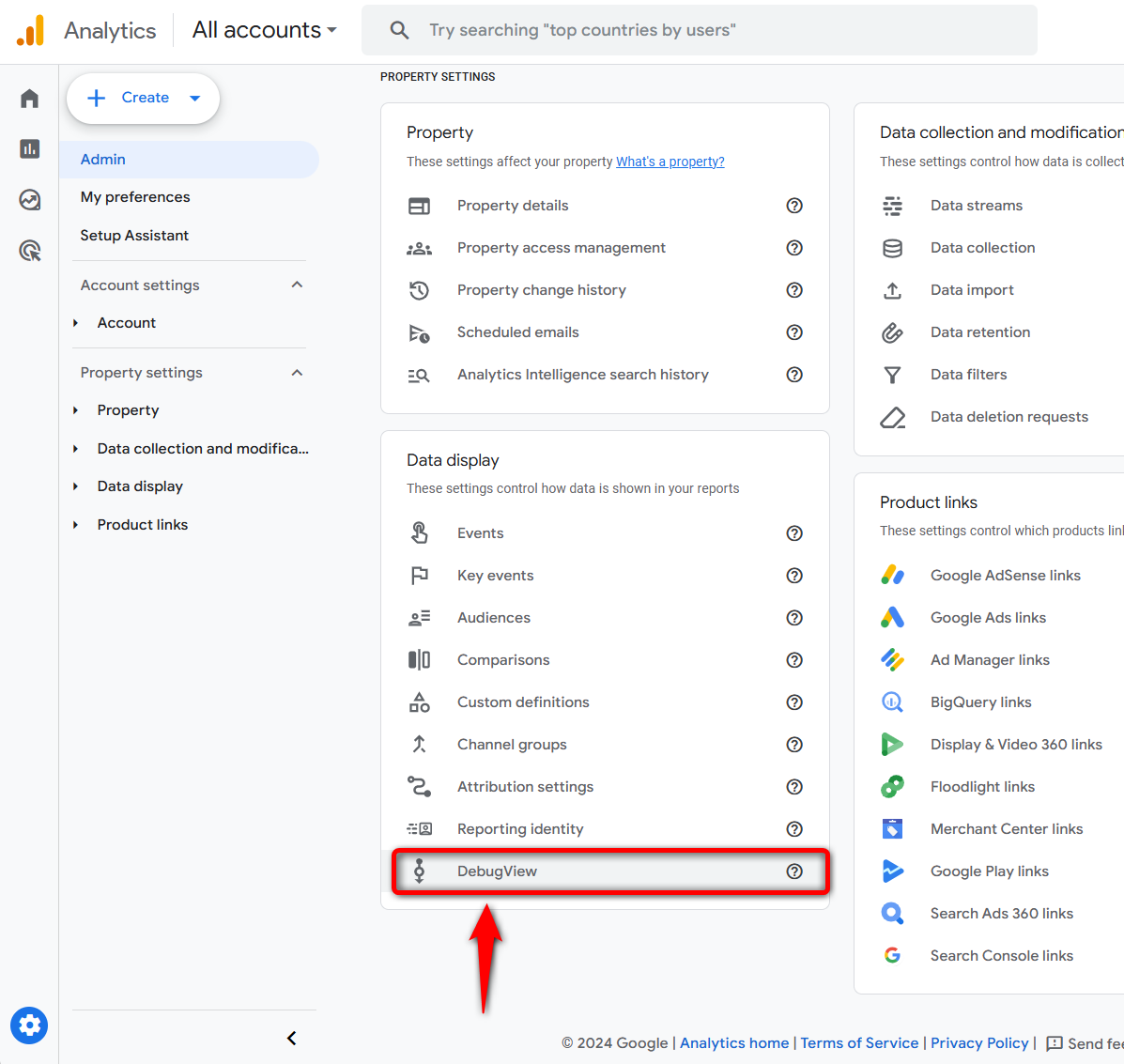
It'll show all the events getting triggered on your website based on your user's activities in a timeline.
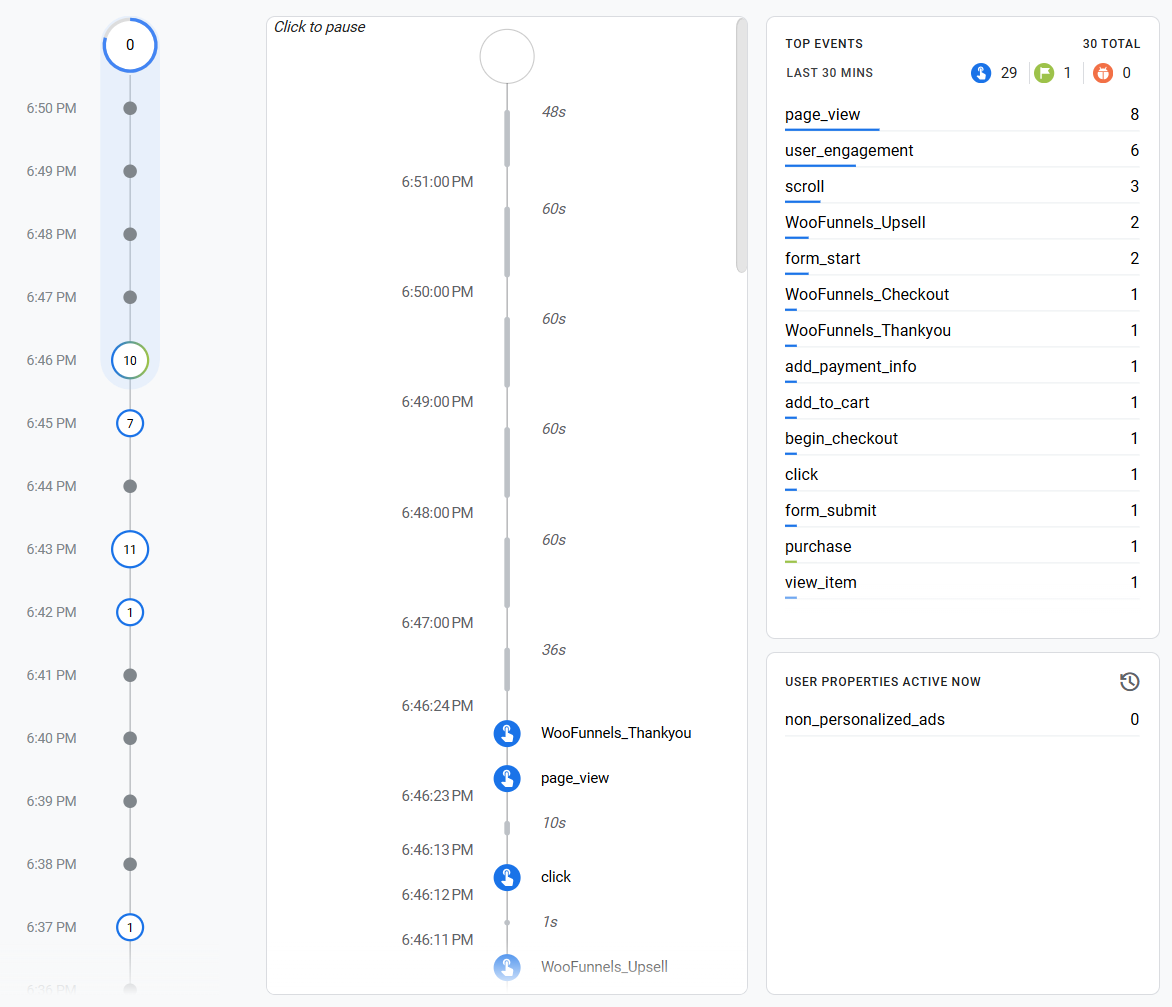
Since all the events were captured, it means they are successfully being fired to the Google Analytics ID.
The data and reports for a particular day will be generated after 24 to 48 hours. You can view and analyze these metrics from there as well.
This means that events are successfully getting tracked for the Google Analytics 4 property in your WooCommerce store.
This is how you can test and verify the Universal and Google Analytics 4 implementation and events firing/capturing on your WooCommerce store.
Frequently Asked Questions (FAQs) on WooCommerce Google Analytics Integration
Here are some frequently asked questions from users regarding Google Analytics integration with WooCommerce.
Do I need Google Analytics with WooCommerce?
Yes, you can connect your WordPress website to Google Analytics. All you need is one plugin, FunnelKit, to establish this connection.
How do I connect Google Analytics to WooCommerce?
Connecting Google Analytics to WooCommerce is relatively easy. Enter the Google Analytics ID into the FunnelKit dashboard, and you’re good to go. You can follow this post for step-by-step instructions on how to set up WooCommerce Google Analytics integration.
Can I track events of both UA and GA4 iterations with FunnelKit?
Yes, you could track conversions of both UA and GA4 iterations with FunnelKit simultaneously. Just enter the UA and GA4 IDs separated by a comma, one after the other. But please note that Google has discontinued its UA version and replaced it with GA4 as of July 1, 2023.
Can I track individual product performance with Google Analytics?
Yes, you can track individual product performance, customer behavior, and other key metrics using Google Analytics.
Will this duplicate my data if I already have Site Kit installed?
Yes, it can. If you use FunnelKit for analytics, we recommend disabling the "Ecommerce" tracking features in other plugins to prevent the 'Purchase' event from firing twice.
Can I track subscriptions?
Yes, FunnelKit captures the initial purchase value of subscription products. You get the purchase events of product ID, subscription item, value, and other recurring data to track your subscriptions.
How do I know if my data is accurate?
Use the "DebugView" in GA4 as described in the guide above. It is the only way to see raw event data in real-time.
Here are some additional resources for you:
- Set Up WooCommerce Facebook Pixel
- Add TikTok Pixel to WooCommerce
- Add Snapchat Pixel to WooCommerce
- Set Up Google Ads Conversion Tracking In WooCommerce
- Enable Pinterest Conversion Tracking In WooCommerce
Ready to Track Conversions with WooCommerce Google Analytics Integration?
For WooCommerce store owners, it’s crucial to keep a close eye on user behavior and monitor eCommerce conversions.
You can do that with Google Analytics.
Google Analytics will tell you about your store’s performance - sales, user activities, abandonment, and almost anything else you want to know.
But first, you need to establish the WooCommerce Google Analytics integration in your store.
FunnelKit lets you achieve that in a few minutes. Not just that, it also lets you build beautiful sales funnels to boost conversions in your store.
Furthermore, FunnelKit is compatible with all iterations of Google Analytics, i.e., Universal and the latest GA4, allowing you to track event-based conversions in your WooCommerce store.
It also has site-wide event tracking that doesn’t require installing any extra plugins on your WordPress website.
Not just that, the premium version of FunnelKit Funnel Builder lets you create custom checkout pages, order bumps, one-click upsells, etc., to help you grow your business.
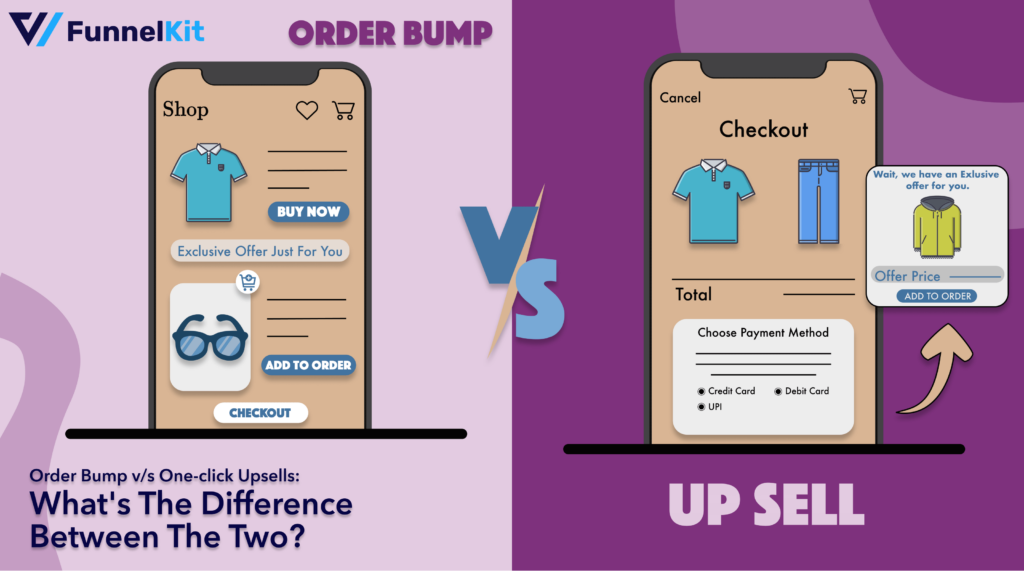
Editorial Team
December 17, 2025Order Bump v/s One Click Upsell: Which one to choose? We got this question from a handful of our customers: "What's the difference between a one-click upsell and an order...
Editorial Team
December 17, 2025You’ve launched your Pinterest campaigns and the clicks are coming in, but your WooCommerce dashboard and Pinterest Ads Manager tell two completely different stories. This is one of the most...

Editorial Team
December 12, 2025Do you want to create an Opt-in page on WordPress that converts more visitors into leads? Most visitors leave your site without buying. In fact, data shows that 76% of...

